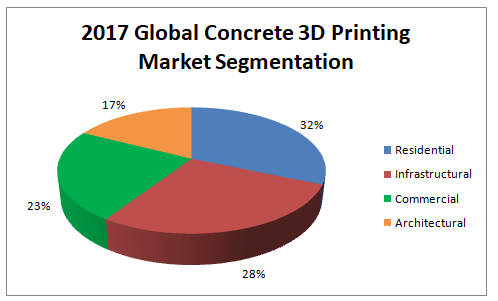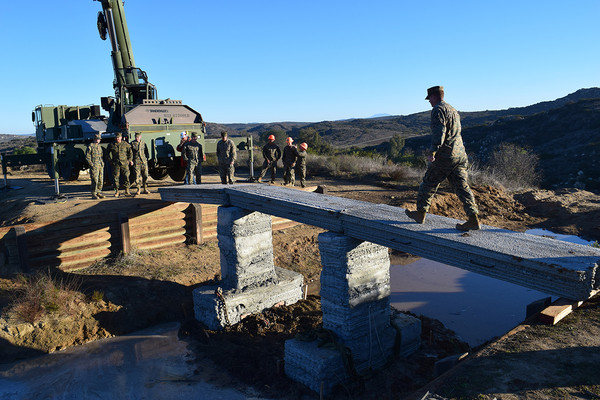![3D printed concrete footbridge created by United States Marines [Source: Defense Logistics Agency ]](https://fabbaloo.com/wp-content/uploads/2020/05/Concrete1_img_5eb0957848a6b.png)
Charles Goulding and Liam Nixon of R&D Tax Savers examine concrete 3D printing.
Concrete 3D Printing: Homes and Infrastructure
3D printed concrete is being used to create both houses and infrastructure.
Housing is an area that has already had major breakthroughs in the area of concrete 3D printing. For instance, a circular, concrete home was created utilizing 3D printing technology in Russia. The home was created by Apis Cor, a company that specializes in producing equipment for construction by 3D printing. The home was constructed using a “crane-sized” 3D printer. In Latin America, the plans have already been made to create an entire neighborhood of 3D printed homes. The homes are expected to be produced at a similar pace as the home in Russia. These homes, which are being designed to alleviate homelessness, are low-cost and only 375 square feet. The neighborhood is being constructed for poor families. Lastly, scientists in Singapore designed and created a 3D printed bathroom in 12 hours and relied upon a specifically-designed concrete. These three examples highlight the increasingly-prevalent area of 3D printed homes. Cost-efficient 3D printed homes can definitely benefit not only people, but also the economy.
In addition to making strides in housing, there have also been relevant developments in infrastructure with regards to concrete 3D printing. On the west coast of the U.S., the University of New Mexico has started using two concrete 3D printers. They have big aspirations of utilizing this technology for bridges and buildings. Their efforts can prove to be valuable for implementing infrastructure more efficiently in the future. In New York City, a small company named Toggle plans to implement concrete 3D printing robots. These robots are a part of a larger cohort of industrial robots that Toggle plans to create to accelerate the effectiveness of infrastructure projects. Also, United States Marines have contributed to infrastructure innovation by 3D printing a footbridge utilizing concrete at California’s Camp Pendleton. For the Marines, their intention is for this structure to be the start of a large-scale infrastructure initiative that combats natural disasters. The Marines have also dabbled in other 3D printing projects, most notably a barracks building.
Concrete 3D Printing Market Segmentation
Unsurprisingly, homes and infrastructure make up the bulk of the world’s concrete 3D printing. Wise Guy Reports has published an extensive report on the global market for concrete 3D printing. According to this report, residential concrete 3D printing accounted for over 31 percent of the 2017 global market for 3D printing, while infrastructure accounted for almost 28 percent. This data means that nearly 60 percent of the market share of concrete 3D printing is for housing and infrastructure, clearly making them the two most prevalent areas of concrete 3D printing.

Columbia University’s Strides in 3D Printing
Strides in concrete 3D printing are being made all across the world, at many different organizations. Columbia University professor Shiho Kawashima has completed extensive work in the area of concrete 3D printing. She was awarded a CAREER Award from the National Science Foundation for her excellence in the field.
In addition to concrete 3D printing work, Columbia has impressed with their breakthrough in wood 3D printing. Their researchers created replica wood material utilizing 3D printing technology. Their printed material is not far off from real wood.
Conclusion
The 3D printing industry has made major strides in numerous areas. More specifically, the concrete 3D printing industry has had multiple successful developments, particularly in housing and infrastructure. These two markets make up nearly 60 percent of the market share in concrete 3D printing. Columbia University has also completed substantial research in both concrete and wood 3D printing. Working on projects in the realm of 3D printing may result in qualification for the now-permanent R&D tax credit.
The Research & Development Tax Credit
Enacted in 1981, the now permanent Federal Research and Development (R&D) Tax Credit allows a credit that typically ranges from 4%-7% of eligible spending for new and improved products and processes. Qualified research must meet the following four criteria:
-
Must be technological in nature
-
Must be a component of the taxpayer’s business
-
Must represent R&D in the experimental sense and generally includes all such costs related to the development or improvement of a product or process
-
Must eliminate uncertainty through a process of experimentation that considers one or more alternatives
Eligible costs include U.S. employee wages, cost of supplies consumed in the R&D process, cost of pre-production testing, U.S. contract research expenses, and certain costs associated with developing a patent.
On December 18, 2015, President Obama signed the PATH Act, making the R&D Tax Credit permanent. Since 2016, the R&D credit has been used to offset Alternative Minimum Tax (AMT) for companies with revenue below $50MM and, startup businesses can obtain up to $250,000 per year in payroll tax cash rebates.











COBOD’s BOD2 construction 3D printer seems to be catching on as the company has made multiple sales of the new device.